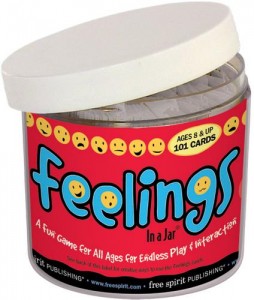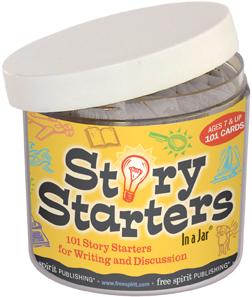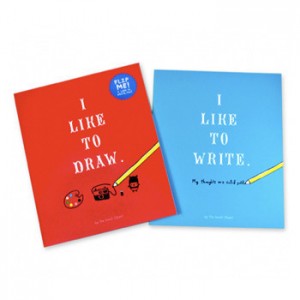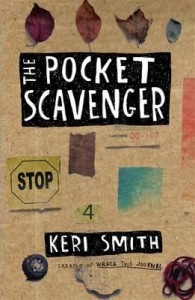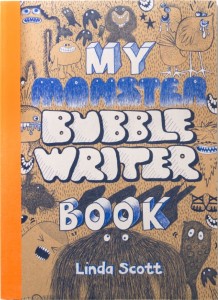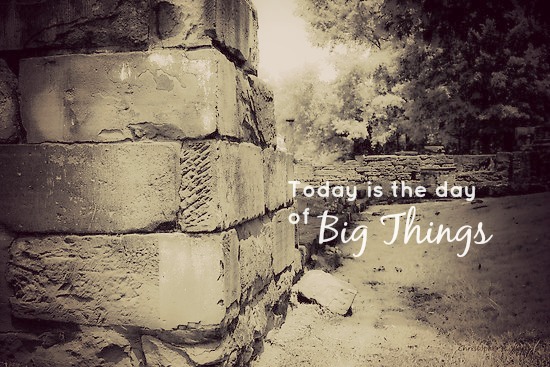Do you think you’re creative?
When second graders are asked this question, 95% of them answer yes. Jump ahead to 5th grade, and only 50% think they are creative. Eventually, ask high school seniors, and only 5% will say they think they are creative.
The numbers don’t surprise me. My older two—11 and 9—know now what makes “good art” and get frustrated when their drawings don’t look just right. They are more and more aware of the struggle of having a creative idea, not being able to make it happen as it looked in their head, and then feeling like scrapping the vision altogether.
But, I want my kids to be in that 5% years from now. As their mother, I’ve got a big task before me—build up in them collaboration and thinking in a new way to make new things. I want to allow them space to be distracted with ideas. I want to teach them grit—the courage to fail, persevere, and keep trying. And, like I do with a lot of different things, I am using books as a good place to start.
Here are a bunch of the titles that I’m using now or hoping to use to keep those wheels turning, headed in the right direction.
*note* I grouped them by age but, honestly, I love every one of these titles myself. So, not sure how accurate my age brackets are. Whatever. Think creatively about it.
Great creativity builders for prereaders or early readers (and parents):
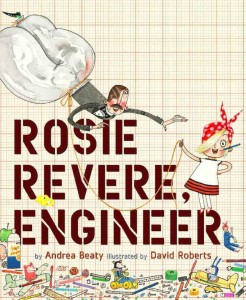 My current favorite storybook (see a whole post about it HERE). With charming illustrations and people of all different shades, simply put, Rosie Revere, Engineer
My current favorite storybook (see a whole post about it HERE). With charming illustrations and people of all different shades, simply put, Rosie Revere, Engineer encourages science and making and building for girls. It serves as a tribute to the real Rosie the Riveter generation that came before us. But, more than all that, it’s a simple sort of parable for mommies, daddies, and boys and girls alike that there’s such a thing as “perfect failure” as you practice creativity and take initiative to create things to solve problems, leading us all to stand and cheer. Love it…and love that I can never seem to find our copy because someone always seems to have it in a stack by their bed.
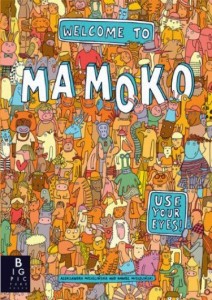 I bookmarked Welcome to Mamoko
I bookmarked Welcome to Mamoko for Lydia but discovered that it’s really good for all my kids. The only words are in the inside cover, introducing you to the characters and asking a question about each one that is answered in the pages that follow. They’re cute little characters like Claude Van Clue and a turtle named Boris Greenshell who carries a bag with a hole in it. On the pages that follow, all substantially sized board pages so great for “reading” over and over, you make up your own stories based on incredibly detailed illustrations. The questions from the beginning can be story prompts, or you can skip those entirely and just be creative with your own story. Great look, feel, and concept for building creativity in kids and doing it together as a family taking turns with the story you create.
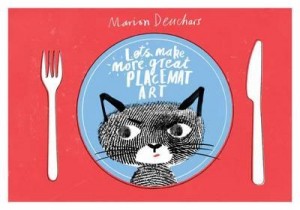 Chicken tenders and fries aren’t the only thing my children love about eating out. They are also total suckers to the kids’ menus—you know the ones that have activities and things to draw and all that jazz. This big ole book Let’s Make More Great Placemat Art
Chicken tenders and fries aren’t the only thing my children love about eating out. They are also total suckers to the kids’ menus—you know the ones that have activities and things to draw and all that jazz. This big ole book Let’s Make More Great Placemat Art recreates that excitement for home—and is one of the gifts I’m giving this year to a little person in our life. It has lots of different fun art prompts on big sheets of paper, perfect for keeping your kiddos busy while you are making dinner or trying to actually have a conversation with the big people around your table. *Note* don’t give them crayons that break in two seconds like the restaurants do.
No, it’s not a book like the rest on this list but still a great creativity builder that easily fits on a bookshelf. Feelings In a Jar, part of Free Spirit Publishing’s jar series, includes 101 small cards that have one feeling word on each card—unhappy, relaxed, hopeless, startled, accepted, mixed-up, peaceful, cheerful, spirited, agitated, etc. There are so many ways parents (and educators) could use these cards—choose a random card and act it out while others guess which feeling it is, have everyone choose a random card and take it on all during dinner together, choose a random card and share the last time you felt that way, choose a random card and draw a picture of someone in a situation that may cause him or her to feel that way. As a mother of two children who need help navigating emotions, this is definitely a tool for my mothering and shepherding toolbox. Note that it says for ages 8 and up—I think that’s simply because of reading and some of the vocabulary being a bit more advanced. But, I plan on using this in all kinds of ways with our preschooler.
I may start drawing on this resource instead of reading another bedtime story to my little one. Another resource from the same collection from Free Spirit Publishing, Story Starters In a Jar includes 101 cards with story starting prompts that all end with ellipsis points—”Crack! The loud noise frightened me, and I jumped out of bed to discover…” “When the snow falls, I always…” “On my last deep-sea dive I discovered the most amazing…” If kids are looking for something to write about or a theme for a family play, have them draw out a card. For the younger set, I’m thinking I let her draw a card and simply tell me a story verbally so that I can get a break from reading the same favorite bedtime story over and over again. She gets a creativity boost, and I get a little break and a whole lot of entertainment.
Great creativity builders for age 7+ (and parents):
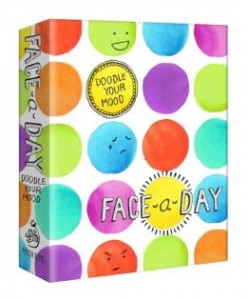 I wanted to build my younger son’s creativity with words about feelings and daily happenings. When I found Face-a-Day Journal: Doodle Your Mood
I wanted to build my younger son’s creativity with words about feelings and daily happenings. When I found Face-a-Day Journal: Doodle Your Mood, I knew it would be a great tool for him/us. Each 2-page spread features a colorful empty circle like the ones on the cover opposite very simple prompts, giving a space to write the date, circle the weather, note what you ate for three meals, and then share freely what was a thumbs up and a thumbs down for the day. Seems like a great resource for building verbal skills, emotional awareness, and artistic creativity with the face he can complete each day. And, in the end, I’m thinking we’ll have a pretty neat flip book to see all the faces of Drew.
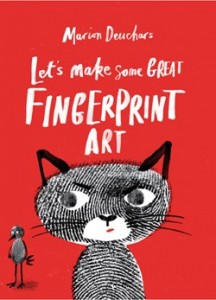 Let’s Make Some Great Fingerprint Art
Let’s Make Some Great Fingerprint Art is another great title from one of my favorite fun publishers, Laurence King. It’s loaded with all sorts of art you can create out of fingerprints. And, not only is it a fun activity book for your kiddo, it will give you a ton of pages you can either rip out to send to grandma or a ton of ideas you can recreate on your own to make Valentine’s cards, birthday cards, or some frameable art for gifts. So, maybe this one counts as a creativity builder for parents too? *Note* you do need ink pads for this one and, therefore, baby wipes or something close by. I’m not a fan of mess myself.
I Like to Draw/I Like to Write is the perfect travel companion. Big enough to captivate you, small enough to fit in my bag. Want to draw? Grab a pencil and complete the full color pictures, be inspired by prompts. Want to do something else, something more wordy? Flip the book around and start working from that side from prompts to create word maps, write your own fortune cookie fortunes, imagine what scribbled out notes may have said, and other super fun activities. Even if your kids are too young to get into writing out stories per se, these prompts are great conversation starters. Just let them complete the prompt aloud instead. Yeah, this one has got to just stay in my purse for doctor waiting rooms and long car rides.
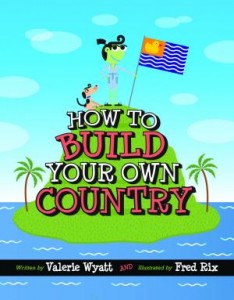 How to Build Your Own Country
How to Build Your Own Country is on Evan’s please-please-please list. It’s perfect for him and the whole crew and is all about fostering creativity as well as global citizenship. It’s a kids’ guide to starting a nation from scratch, starting with branding and growing a population to setting up a government, writing a constitution and laws, getting along with other nations, and serving your citizens. I’m already predicting some amazing role playing between our children as they all become founders/presidents/dictators? of their own nations. I can’t wait to see what unfolds…and am wondering if I may find myself busy sewing flags and printing out passports come Christmas vacation.
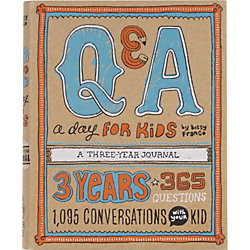 I can’t decide if this gift is more appreciated by the child or his or her parent. I really do love it myself that much. Q & A a Day for Kids: A Three-Year Journal
I can’t decide if this gift is more appreciated by the child or his or her parent. I really do love it myself that much. Q & A a Day for Kids: A Three-Year Journal is the kids version of a popular 5 year diary for adults. Every page is dated (month and day) and then asks a question like “What age would you like to be? Why” and “What are the worst jobs you’ve ever heard of?” and “I make a good friend because ____.” Then, there are three sections of lines for your child to answer–the first year, he or she writes in the first section. When the year is up, you start all over again. Everyday, your child is encouraged to think creatively, express himself or herself, and grow his or her self-awareness. And, at the end of three years, even if some days are not completed, you have a keepsake that you may just pull out at her bridal shower. It’s really that good.
Oh how I love Keri Smith books; she seriously must exhale creativity with every breath. The Pocket Scavenger is so stinkin’ clever. It starts like this: “In the following pages, I’m going to ask you to search for a bunch of items. At first glance, these may seem like simple, mundane, inconsequential things, but don’t be fooled—they are of utmost importance! Every minute of the day there are hundreds (or thousands) of things around us that we don’t notice. Our eyes tune them out because they don’t seem important for our current needs. But what if we look at every ‘thing’ as if we have never seen it before?” Forget your kids; doesn’t that make you want to become a scavenger? The challenge Keri gives is to infuse our daily outings and daily life with a quest to see those seemingly insignificant things with new eyes. On every page is an item to find with space to write where it was found, the date, the time, and the story of either finding it or maybe how you see it in a new way simply because it is now in your sight. Love the concept and really hope that this can become a tool we use to make walks at the national park and downtown more of an adventure.
Great creativity builders for age 9+ (and parents):
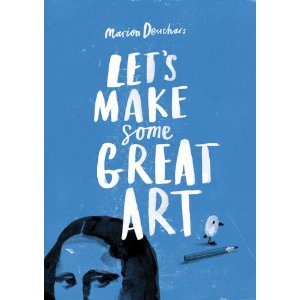 I love books like this as do my kiddos. Let’s Make Some Great Art
I love books like this as do my kiddos. Let’s Make Some Great Art is inspiring, starting with the first quote from Pablo Picasso that looks like it was written in pencil by the author just for you: “Some painters transform the sun into a yellow spot, others transform a yellow spot into the sun.” (#wordstoliveby) This book is full of inspiring ideas from the very simple complete-this-picture stuff to facts and art prompts based on the Renaissance masters paint mixing and Jackson Pollock. It has lots of educational stuff packed in there in such a way that kids won’t even realizing they are learning. Perfect.
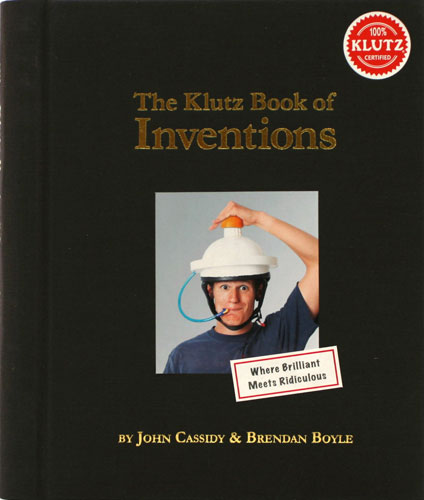 I think this book was written specifically for my son. The Klutz books are known for being creativity builders. And, this one—The Klutz Book of Inventions
I think this book was written specifically for my son. The Klutz books are known for being creativity builders. And, this one—The Klutz Book of Inventions—is just great. Nearly 200 pages showcasing 162 different inventions, some that will make you ooo and ahhh and some that completely gross you out (think venting pants). But, there’s something about reading about all these different ways that people saw a problem and created something to address it that stirs up all the creative juices in you. In the intro, it says: “The lesson here for any inventor-to-be is play with your problem. Do not be afraid. Go for lots of ideas, ridiculous to practical, and then go back looking for winners. Celebrate your mistakes, learn from them, and if people call you absolutely, 100%, no-question-about-it nuts…you’re probably getting warm.” Love that.
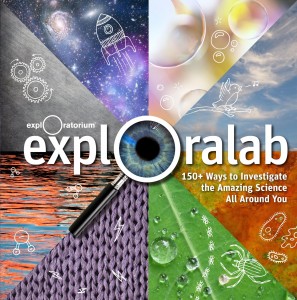 There’s something really empowering when a kid realizes that science and creative thinking aren’t restricted to classrooms. Exploralab
There’s something really empowering when a kid realizes that science and creative thinking aren’t restricted to classrooms. Exploralab is filled with interesting ways to engage creatively with the world around us. Featuring over 100 mini-scientific adventures, my son may actually start to believe that some of the stuff he hears about in school really does apply to real life. AND…this title may become my one word reply when I hear the dreaded, “I’m bored.”
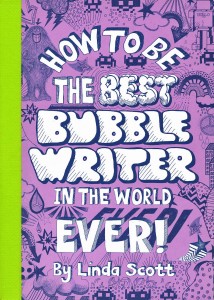 “This book is here to change your life. Well, maybe not ALL your life but definitely the bits that involve making posters, designing logos, creating your band name or pretty much ANYTHING in this loverly world that needs fun words, cool words and words that just HAVE to catch your eye.” If I didn’t read the title and didn’t see the cover, I may just think How to be the Best Bubblewriter in the World Ever
“This book is here to change your life. Well, maybe not ALL your life but definitely the bits that involve making posters, designing logos, creating your band name or pretty much ANYTHING in this loverly world that needs fun words, cool words and words that just HAVE to catch your eye.” If I didn’t read the title and didn’t see the cover, I may just think How to be the Best Bubblewriter in the World Ever was for me. But, I guess it’s for my 4th grade daughter…unless I steal it from her when she isn’t looking. The pages are so much fun that you forget that it’s all just in greyscale. That doesn’t matter anyway because it’s the bubble-writer-in-training who is going to make the pages come alive with creative color.
London author Linda Scott strikes a great balance between prompts to inspire and freedom for creative license in her second book My Monster Bubblewriter Book. I find myself wanting to draw words that look like their meaning and make my letters into adorably creepy little monsters after flipping through this one. Don’t let the title fool you either—it isn’t just about making fun letters. It promises this: “By the time you finish this book you will either be a ‘Monster-Drawing-Bubble-Writer’ or a ‘Bubble-Writing-Monster-Drawer.'” Can’t decide who would like this one more—my 11 year old son or my 9 year old daughter—it’s definitely more unisex than her first title that my son wouldn’t be caught dead with. I think this one would be a great team creativity builder for them.
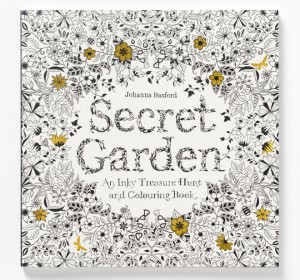 Perfect for a girly girl. Scottish illustrator Johanna Basford’s Secret Garden: An Inky Treasure Hunt and Coloring Book
Perfect for a girly girl. Scottish illustrator Johanna Basford’s Secret Garden: An Inky Treasure Hunt and Coloring Book inspires all sorts of artistic creativity with flora and fauna. This could keep the older elementary school girl like mine busy for hours and would make a great gift paired with the classic book
or with the coordinating Secret Garden postcards
or journals.
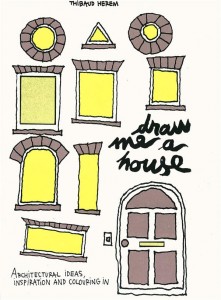 When I was little, I remember spending afternoons alone with graph paper, designing buildings and how to arrange rooms (complete with a line down the middle for those shared between two sisters, mind you). Maybe that is what attracted me to Draw Me A House: A Book of Colouring in, Ideas and Architectural Inspiration
When I was little, I remember spending afternoons alone with graph paper, designing buildings and how to arrange rooms (complete with a line down the middle for those shared between two sisters, mind you). Maybe that is what attracted me to Draw Me A House: A Book of Colouring in, Ideas and Architectural Inspiration, my own secret desire to spend a day with my graph paper once again. It’s so much more than a coloring book; it’s more of a design-building book—design clocks, lamps, playgrounds, mobile homes, fireplaces, houses that can endure extreme temperatures, luxury dog houses, etc. And, architectural tidbits are spread throughout—Alvar Aalto, Le Corbusier, Falling Water…
I’m Evan will really like this one.
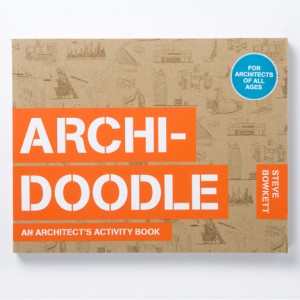 Archidoodle: The Architect’s Activity Book
Archidoodle: The Architect’s Activity Book is a bit more grown up than Draw Me a House and perfect for the older child who may be offended at a gift that could be interpreted as a coloring book. It’s a bit more challenging (for example, has a floor plan for the Berlin Building Exhibition and asks you to use a drawing key to mark on the plan the spaces where you would cook, eat, sleep, etc.) And, every page showcases some renown or not-so-renown-but-should-be design from the Brazilian National Congress Building to Casa Batillo to Buckingham Palace. Great for aspiring designers like my older two kids but also a great gift for an art teacher or an architect or engineer-ish person. In fact, I wish Steve Bowkett and Laurence King Publishers would make this book into a series. My uncles would love one of these all based on signs and ads.
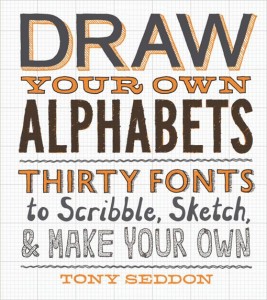 Once upon a time, there were no computer fonts. There was only hand lettering which “kept a lot of monks in gainful employment.” Now that computers are what they are, fonts sorta rule…but hand lettering is still really awesome. And, honestly, my favorite graphic design art has that hand drawn look. With a more grown-up look about it with no coloring pictures and great info about hand lettering, type, bitmaps vs. vectors, etc., Draw Your Own Alphabets
Once upon a time, there were no computer fonts. There was only hand lettering which “kept a lot of monks in gainful employment.” Now that computers are what they are, fonts sorta rule…but hand lettering is still really awesome. And, honestly, my favorite graphic design art has that hand drawn look. With a more grown-up look about it with no coloring pictures and great info about hand lettering, type, bitmaps vs. vectors, etc., Draw Your Own Alphabets is a great creativity builder for the older kid who is into or wants to get better at hand lettering, drawing, and graphic design really. Fonts are showcased alongside a page of graph paper to practice your own version and develop new alphabets.
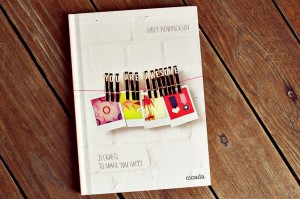 My little crafty entrepreneur is always looking for crafts to make. While You Are Awesome: 21 Crafts to Make You Happy
My little crafty entrepreneur is always looking for crafts to make. While You Are Awesome: 21 Crafts to Make You Happy is not geared towards kids, it features very easily doable crafts that have Etsy and Pinterest written all over them. Ashlyn would love to tear this book apart and be inspired by ideas like Valentine medals, a doorknob mailbox, and stenciled magnets made out of little slices of a branch. Maybe you’ll see some new things on her Etsy shop…who knows.
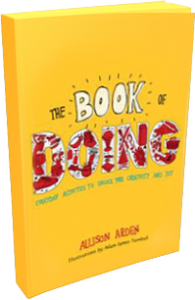 In The Book of Doing: Everyday Activities to Unlock Your Creativity and Joy
In The Book of Doing: Everyday Activities to Unlock Your Creativity and Joy, author Allison Arden seeks to inspire the grown-up set. It includes about 180 pages of all sorts of ideas of solutions to boredom and inspiring prompts (e.g., throw a themed party, watch an academy award winning movie, eat oatmeal everyday for three weeks, imitate a piece of museum art…). While this would be a fun coffee table book for families and young adults, you may want to rip out a couple pages. Pages 19 and 38-39 do tastefully (literally?) reference martinis and cocktails. But, aside from that, it looks like a creativity booster for all sorts of folks.
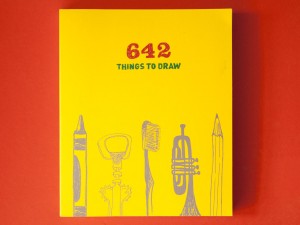 The 642 Things to Draw Journal
The 642 Things to Draw Journal is your tangible reply to the statement every parent has heard, “But I don’t know what to draw.” This book is nearly blank on every page (no complete the pictures or coloring book type of thing here) except for fine print on every page simply prompting ideas of things to draw that you or your child may not have otherwise thought of—synchronized swimmers, a seagull, a power tool, a snout, a weathervane…Great for older kids as well as a fun gift for adult artist types. Parents, note that there are some prompts in here that your child likely won’t know (and you will…which will make you feel old) like David Bowie, Charlie Chaplin, and a rotary phone. Also note that while I have not read all 642 prompts in the book, I did flip through and see one that said “a drunken sailor” as a little FYI.
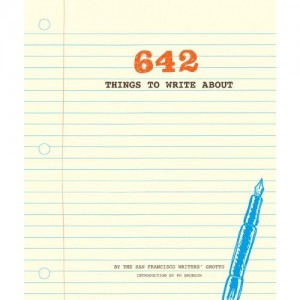 The companion to the above title, the 642 Things to Write Journal
The companion to the above title, the 642 Things to Write Journal is a great tool for parents to use when we’re asked, “But what should I write about?” Full of writing prompts provided by San Francisco Writer’s Grotto, this book of literary creativity starters helps get things moving—”A character discovers an object hidden many years ago in a family home…,” “Explain to your boss why you spent $5,000 during one business trip and why he should reimburse you,” “Write a script to give telemarketers to sell plastic pooper-scoopers.” I wish Chronicle Books would publish 642 Things to Write About FOR KIDS, however. I love the concept and even the set up and look of this book. But, because it’s geared towards adults, there are prompts in there that are adult enough that I wouldn’t want to simply give this to my children—just flipping through, I saw prompts about a bar, a suicide helpline, meeting your child’s girlfriend who is old enough to be his mom, and a drug addict. But, because there are 642 in here, I still like it; there are plenty of really clever ones that you could use to help kids get started or to just throw out during dinner to lead to some fun and clever conversation. While you’re at it, Chronicle Books, can you also publish one called 642 Things to Blog About?
There’s my working post of creativity builders, a few tools to teach grit and perseverance and keep-on-keeping-on to my wee designers, artists, thinkers, inventors, and entrepreneurs. As I discover new titles, I’ll add more to the list and keep sharing. Got any you like that I should add to my list?
